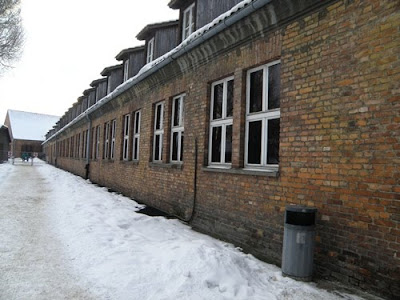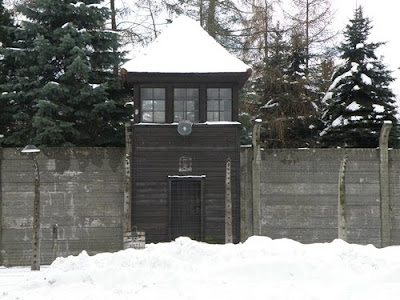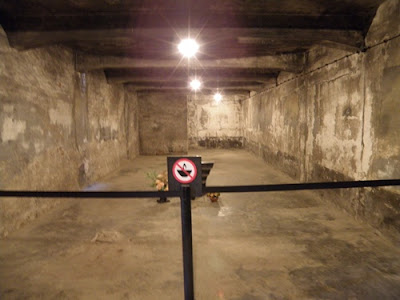Early morning we arrived at the town of Oswiecim where the Nazis operate a networkl of concentration and examination camps built in and around the town.
Our guide tour begins from the main camp- Auschwitch I.
A somber experience as we stand witness to the terror that gripped the hearts of many during WWII where the atrocities and cruelties faced, mostly by the Jews were indescribable.
To conceal what was happening in Auschwitch and to reserve further lands for future industrial and agricultural activity, in 1940 the SS declared an area of 40 sqm around Auschwitch and Birkenau an interessengeblet, or special interest zone. Most of the Poles living in the area were expelled in 1940 and 1941. Some of the houses from which the Poles were evicted were assigned to SS personel and their families. Some were used to house services for the SS garrison, other were dismantled.
From 1940 to 1944 the camp authorities set up various farms, factories and workshops in this area, using prisoners as slave labour.
Within the interessengeblet, many thousands of prisoners died from beatings inflicted by SS guards and prisoner overseers(kapos), from the inhumane conditions of slave labour or were simply shot.

Throughout the world, Auschwitch has become a symbol of terror, genocide,, and the Holocaust. The German forces occupying Poland during the WWII established a concentration camp, on the outskirts of the town of Oswiecim, in 1940; the Germans called the town Auschwitch and that is the name by which the camp was known. Over the next years it was expanded into 3 main camp: Auschwitch I, Auschwitch II-Birkenau, and Auschwitch III- Monowitz and more than 40 subcamps. The first people to be brought to Auschwitz as prisoners and murdered here were Poles. They were followed by Soviet prisoners of war, Gypsies and deportees of many other nationalities. Beginning in 1942, however, Auschwutz became the setting for the most massive murder campaign in history when the Nazis put into operation their plan to destroy the entire Jewish population of Europe.
The great majority of Jews who were deported to Auschwitz- men, women and children- were sent immediately upon arrival to death in the gas chambers of Birkenau.
When the SS realised that the end of the war was near, they attempted to remove the evidence of the atrocities committed here. They dismantled the gas chambers, crematoria and other buildings, burned documents and evacuated all those prisoners who could walk to the interior of Germany. Those who were not evacuated were liberated by the Red Army on January 27, 1945.
On July 2, 19*47, the Polish Parliament established the State Museum of Oswiecim- Brezinka on the sited of the former camps at Auschwitz I and Auschwitz II- Birkenau. In 1979, these camps were formally recognized by UNESCO by their inclusion on its World Heritage List.
This is our guide explaining to us.


















Block 11 was known as the "Death Block". It served several functions, of which the most important was its role as the central camp jail. Male and Female prisoners from all parts of the camp complex were held in this building. Most of these people were suspected by the camp Gestapo of involvement in clandestine activities: attempting to escape, organizing mutinies and maintaining contacts with the outside world.
Poles from outside the camp who had been arrested for rendering aid to prisoners were imprisoned here too. Following brutal interrogations, they were in most cases sentenced to death by shooting. in the early years of the camp the Strafkompanie (penal unit) and Erziehungskompanie (re-education unit) were also held in this block. The prisoners of the penal unit, to which almost all the Jewish men and Polish priests held in the camp at that time were sent on arrival, were assigned to the most back-breaking work; most of them died.
For some time the block also held the Sonderkommando, the special unit of prisoners employed to burn the bodies of the dead.
From 1943 onwards, polizeihaftlinge (police detainees) were also held here. These were Poles from the area under the jurisdiction of the Gestapo in Katowice who were suspected of involvement in the resistance movement. They would be held awaiting sentence from a special German Summary court. Usually the penalty was death.
In the basement, known as the bunker, were punishment cells where the SS confined prisoners regarded as guilty of violating camp regulations. In 1941 prisoners sentenced to death by starvation were held here.
Over the period 3-5 September 1941, the SS carried out experiment in the basement with Zyklon B in preparation for the mass murder of Jews: 600 Soviet POWs and 250 Polish political prisoners, selected from the camp infirmary as human guinea-pigs for this experiment, were murdered here in this way.






Prisoners were confined there four at a time for several or more than a dozen nights. They had to stay in overnight and they had to work during the day. Many died in consequence of suffocation and exhaustion.


The washroom where women stripped before execution. Then they were led in twos to yard and shot at the " Death Wall".




Many corpses of prisoners who were murdered and who died during the last days of the operation of the camp were found in the basement and on the ground floor of barrack 11 by Soviet soldiers after the liberation of the camp.




The interior of a room for prisoners until spring 1941. Prisoners slept crowded together on straw mattresses. In the morning they had to gather up the mattresses and arrange them in the corner of the room.






The interior of a washroom from 1941 to 1945, before these facilities were installed prisoners had only two wells outside the barracks where they could wash.


This is where the camp Gestapo was located. Prisoners suspected of involvement in the camp's underground resistance movement or of preparing to escape were interrogated here. Many prisoners died as result of being beaten or tortured.
The first commandant of Auschwitz, SS- Obersturmbannfuhrer Rudolf Hoss, who wass tried and sentenced to deth after the was by the Polish Supreme National Tribunal, was hanged here on 16 April 1947.


Before the war this building was a munition bunker. From 15 Aug 1940 to July 1943 the SS used it as crematorium. In the Autumn of 1941, the largest room, which had been designed by the camp authorities as a morgue, was adapted for use as an improvised gas chamber, the first of its kind in Auschwitz. Using the gas produced by pellets of Zylon B, many thousands of Jews were murdered here by the SS within hours of their arrival at Auschwitz. Several groups of Soviet POWS were also murdered here in this way, as were sick prisoners whose return to work was consider unlikely. Poles from outside the camp who had been sentenced to death by the German summary court were shot here.
After the establishment in Auschwitz II- Birkenau of 2 more improvised gas chambers in spring and summer of 1942 for the mass murder if the Jews, the gassings here were gradually stopped. Later, with the completion in Auschwitz II- Birkenau of 4 purpose-built gas chambers with crematoria, the burning of corpses here was also stopped (july 1943). The building was subsequently utilized for storage, and then as an air-raid shelter for the SS. The incinerators, chimney, and some of the walls were dismantled and the holes in the roof through the SS had poured Zyklon B were sealed.
A pity we missed the chance to go to Wieliczka Salt Mine as most group members opt not to go:(


























No comments:
Post a Comment